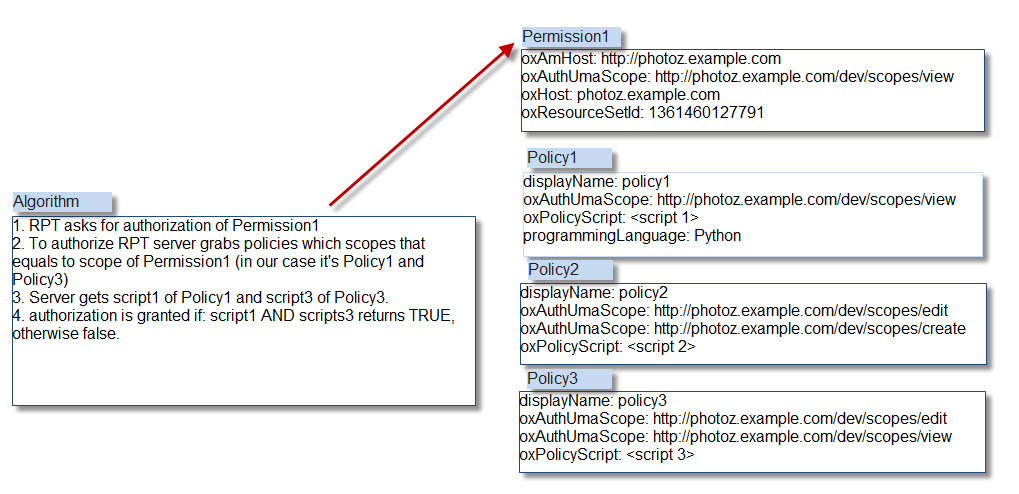User Managed Access 2.0 ("UMA 2")#
Overview#
As a profile of OAuth 2.0 that is complementary to OpenID Connect, UMA 2 defines RESTful, JSON-based, standardized flows and constructs for coordinating the protection of any API or web resource in a way that will be familiar to any developer already acquainted with OAuth.
UMA 2 defines interfaces between authorization servers (AS) and resource servers (RS) that, by default, enable centralized policy decision-making for improved service delivery, auditing, policy administration, and accountability, even in a very loosely coupled "public API" environment. Custom profiles enable flexibility to move the decision-making line outward to distributed applications, to account for local preferences in API ecosystems.
The Gluu Server functions as an UMA 2 AS and provides an interface for scripting unique policies for access management. Learn more about the Gluu Server's UMA-API.
Learn more about the UMA 2 Federated Authorization and Grant specifications on Kantara's website.
Note
If you need to secure apps with OAuth 2.0 RP and UMA 2 RS code, you can use the oxd client software.
Terminology#
UMA 2 introduces new terms and enhancements of OAuth term definitions. For a complete overview of UMA terminology, see the specification.
Authorization Policy Expression Language#
UMA 2 does not standardize a policy expression language, enabling flexibility in policy expression and evaluation through XACML, other declarative policy languages, or procedural code as warranted by conditions.
Authentication-Agnostic#
UMA 2 inherits authentication agnosticism from OAuth. It concentrates on authorization, not authentication. It has been profiled to work with OpenID Connect to gather identity claims from whoever is attempting access, and enables true claims-based authorization (with simple group-based or role-based policies a natural subset).
Resource Registration#
The resources protected by UMA 2 must be registered in oxTrust. The following propterties describe a resource:
- name
- scopes
- type
- icon_uri
The resource type can be a string, URI or any other value type supported by the Gluu Server. The properties shown above are not concrete, and it is possible that a resource may contain custom properties. An example of the resource JSON is given beow:
{
"name":"scim_access",
"icon_uri":"https:\/\/<hostname>\/identity\/uma\/scope\/file\/scim_access"
}
Note
The resource JSON may contain custom properties.
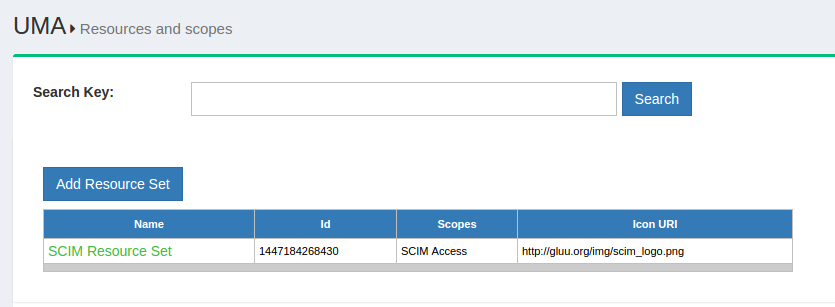
The search bar can be used to find existing available resources. New resources can be added by clicking on the Add Resource Set button which will bring up the interface shown below:

The properties of a resource are visible on this page. There are two additional buttons that allow the administrator to add specific resources and/or scopes. By default, Gluu Server is shipped with SCIM resources protected by UMA. Learn more in the SCIM protected by UMA documentation.


Scopes#
UMA 2 scopes are used to grant a client permission to do an action on a protected resource. Different scopes can grant access to the same action. For example, a "read" action can be allowed with scope "read" or "all". For some actions the Resource Server (RS) may want multiple scopes at the same time. For instance, a "read" action should only be allowed if the authorization request includes the "read" and "all" scopes. UMA 2 scopes are bound to resources and are used to fetch policies that check whether the specified user or client should have access to the resource.
The scopes are described in JSON and have the following properties:
- name
- icon_uri
An example of the scope JSON is given below:
{
"name": "Add photo",
"icon_uri": "https://<hostname>/icons/add_photo_scope.png"
}
Note
The scope JSON may contain custom properties.
The following is an example what an UMA 2 Scope URL may look like:
https://<hostname>/uma/scopes/view
Note
The scope endpoint has to be present in UMA configuration to make it discoverable.
The ldif for both an internal and external scope is given below:
Sample ldif
dn: inum=@!1111!8990!BF80,ou=scopes,ou=uma,o=@!1111,o=gluu
displayName: View
inum: @!1111!8990!BF80
objectClass: oxAuthUmaScopeDescription
objectClass: top
oxId: View
oxIconUrl: http://<hostname>/uma/icons/view_scope.png
Add Scopes#
This section describes the process of adding UMA scopes in the Gluu Server GUI. Scopes are accessed by navigating to the UMA > Scopes in the right hand menu.

The search bar can be used to find existing available scopes. New scopes can be added by clicking on the Add Scope Description button which will bring up the interface shown below:
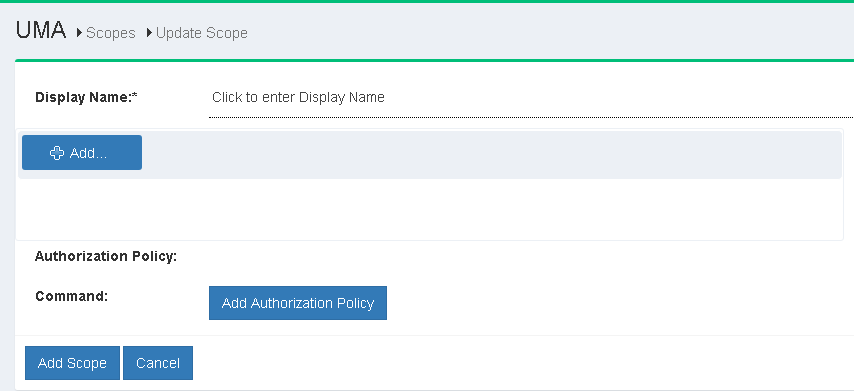
Additionally there is an option to add authorization policy with the new scope.
UMA RPT Authorization Policies#
UMA RPT Authorization policy's are associated with UMA scopes. An authorization request has a resource_id and scope(s). Each scope can point to one or more policies. If all policies associated with all scopes return true, then access is granted.
For example, let's say we have the following resource, GET /photo. In order to access it the Resource Server (RS) requires the read scope to be present. If we have a policy that always return true, then any authorization request to /photo that includes the read scope will result in access granted.
If we wish to have more sophisticated logic, for example to grant access only to a specific client, then we can add something like client_id = "@1111" to the policy. This means that an authorization request to /photo will only be granted if the scope includes read and is coming from client_id = "@1111".
There are three (3) main properties of a policy:
- scopes: policy protects resources by scopes;
- authorization script: script that is evaluated in order to grant/deny access;
- name: a human readable name to the UMA policy.
The following section outlines how to define UMA RPT Authorization policies from the Custom Script menu. The Custom Script page is accessed by navigating to Configuration > Custom Scripts > UMA RPT Policies.
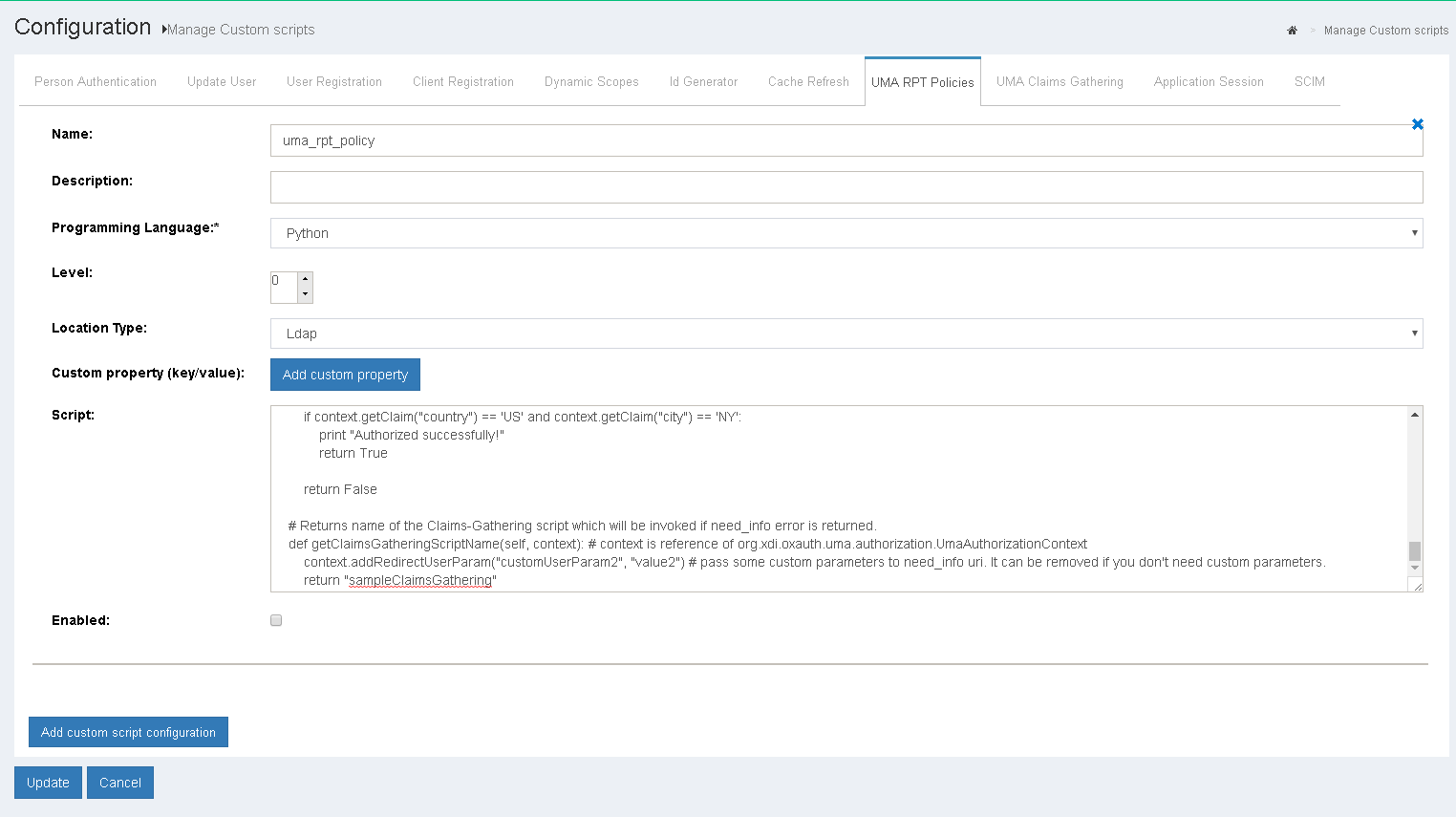
Sample script
# Call sequence
# 1. First is call constructor of the Script __init__
# 2. Next init() method
# 3. Next getRequiredClaims() - method returns required claims, so UMA engine checks whether
# in request RP provided all claims that are required. Pay attention that there can be
# multiple scripts bound to the scopes, means that UMA engine will build set of required claims
# from all scripts. If not all claims are provided need_info error is sent to RP.
# During need_info construction getClaimsGatheringScriptName() method is called
# 4. authorize() method is called if all required claims are provided.
# 5. destroy()
from org.xdi.model.custom.script.type.uma import UmaRptPolicyType
from org.xdi.model.uma import ClaimDefinitionBuilder
from java.lang import String
class UmaRptPolicy(UmaRptPolicyType):
def __init__(self, currentTimeMillis):
self.currentTimeMillis = currentTimeMillis
def init(self, configurationAttributes):
print "RPT Policy. Initializing ..."
print "RPT Policy. Initialized successfully"
return True
def destroy(self, configurationAttributes):
print "RPT Policy. Destroying ..."
print "RPT Policy. Destroyed successfully"
return True
def getApiVersion(self):
return 1
# Returns required claims definitions.
# This method must provide definition of all claims that is used in 'authorize' method.
# Note : name in both places must match.
# %1$s - placeholder for issuer. It uses standard Java Formatter, docs : https://docs.oracle.com/javase/7/docs/api/java/util/Formatter.html
def getRequiredClaims(self, context): # context is reference of org.xdi.oxauth.uma.authorization.UmaAuthorizationContext
json = """[
{
"issuer" : [ "%1$s" ],
"name" : "country",
"claim_token_format" : [ "http://openid.net/specs/openid-connect-core-1_0.html#IDToken" ],
"claim_type" : "string",
"friendly_name" : "country"
},
{
"issuer" : [ "%1$s" ],
"name" : "city",
"claim_token_format" : [ "http://openid.net/specs/openid-connect-core-1_0.html#IDToken" ],
"claim_type" : "string",
"friendly_name" : "city"
}
]"""
context.addRedirectUserParam("customUserParam1", "value1") # pass some custom parameters to need_info uri. It can be removed if you don't need custom parameters.
return ClaimDefinitionBuilder.build(String.format(json, context.getIssuer()))
# Main authorization method. Must return True or False.
def authorize(self, context): # context is reference of org.xdi.oxauth.uma.authorization.UmaAuthorizationContext
print "RPT Policy. Authorizing ..."
if context.getClaim("country") == 'US' and context.getClaim("city") == 'NY':
print "Authorized successfully!"
return True
return False
# Returns name of the Claims-Gathering script which will be invoked if need_info error is returned.
def getClaimsGatheringScriptName(self, context): # context is reference of org.xdi.oxauth.uma.authorization.UmaAuthorizationContext
context.addRedirectUserParam("customUserParam2", "value2") # pass some custom parameters to need_info uri. It can be removed if you don't need custom parameters.
return "sampleClaimsGathering"
UMA 2 Claims-Gathering#
Sometimes RPT Authorization Policy may require additional claims that has to be provided by the user. In this case Claims-Gathering Flow can be used to gather such information. The logic is coded as custom script and can be added by navigating to Configuration > Custom Scripts > UMA Claims-Gathering.
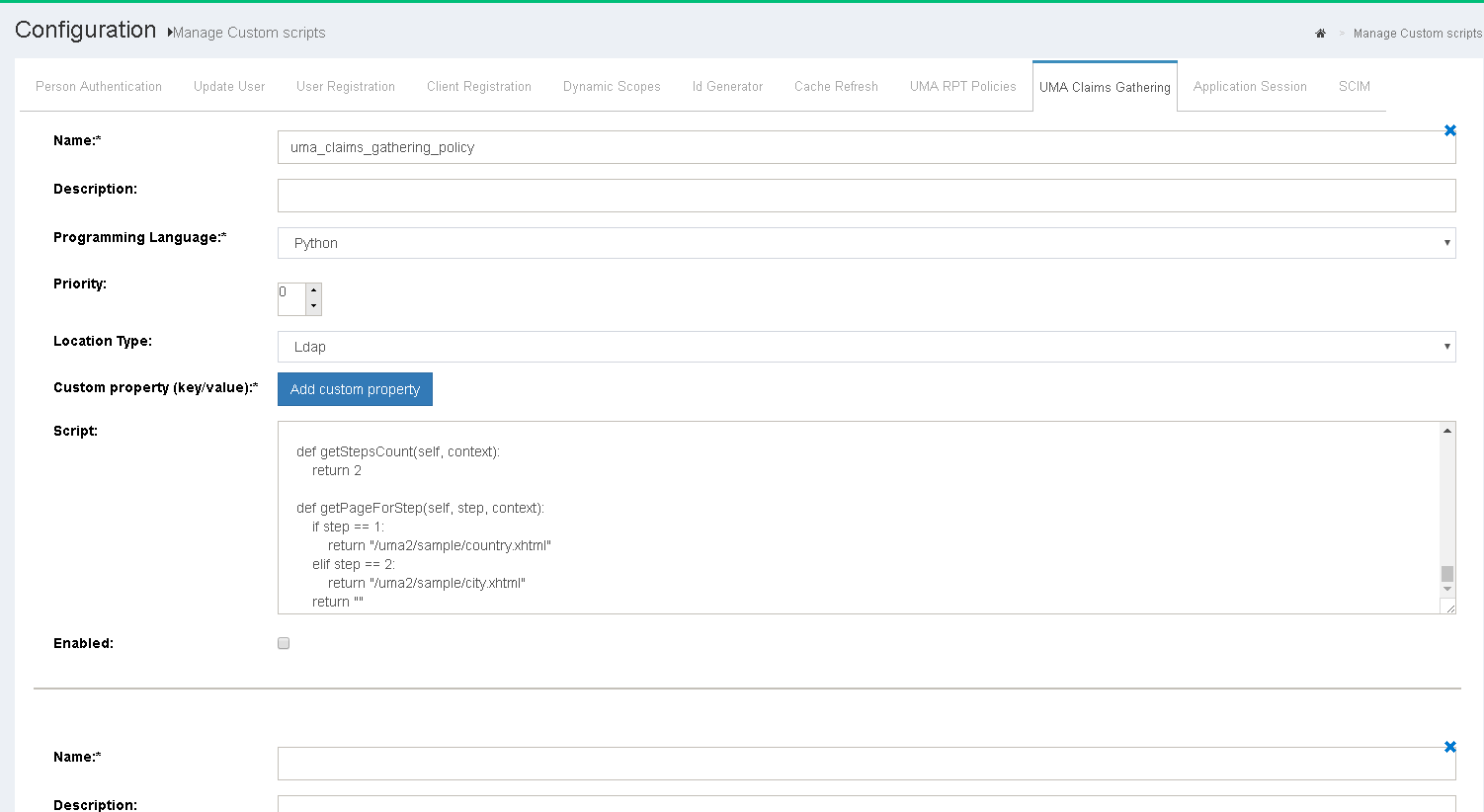
Sample script
from org.xdi.model.custom.script.type.uma import UmaClaimsGatheringType
class UmaClaimsGathering(UmaClaimsGatheringType):
def __init__(self, currentTimeMillis):
self.currentTimeMillis = currentTimeMillis
def init(self, configurationAttributes):
print "Claims-Gathering. Initializing ..."
print "Claims-Gathering. Initialized successfully"
return True
def destroy(self, configurationAttributes):
print "Claims-Gathering. Destroying ..."
print "Claims-Gathering. Destroyed successfully"
return True
def getApiVersion(self):
return 1
# Main gather method. Must return True (if gathering performed successfully) or False (if fail).
# Method must set claim into context (via context.putClaim('name', value)) in order to persist it (otherwise it will be lost).
# All user entered values can be access via Map<String, String> context.getPageClaims()
def gather(self, step, context): # context is reference of org.xdi.oxauth.uma.authorization.UmaGatherContext
print "Claims-Gathering. Gathering ..."
if step == 1:
if (context.getPageClaims().containsKey("country")):
country = context.getPageClaims().get("country")
print "Country: " + country
context.putClaim("country", country)
return True
print "Claims-Gathering. 'country' is not provided on step 1."
return False
elif step == 2:
if (context.getPageClaims().containsKey("city")):
city = context.getPageClaims().get("city")
print "City: " + city
context.putClaim("city", city)
print "Claims-Gathering. 'city' is not provided on step 2."
return True
return False
def getNextStep(self, step, context):
return -1
def prepareForStep(self, step, context):
if step == 10 and not context.isAuthenticated():
# user is not authenticated, so we are redirecting user to authorization endpoint
# client_id is specified via configuration attribute.
# Make sure that given client has redirect_uri to Claims-Gathering Endpoint with parameter authentication=true
# Sample https://sample.com/restv1/uma/gather_claims?authentication=true
# If redirect to external url is performated, make sure that viewAction has onPostback="true" (otherwise redirect will not work)
# After user is authenticated then within the script it's possible to get user attributes as
# context.getUser("uid", "sn")
# If user is authenticated to current AS (to the same server, not external one) then it's possible to
# access Connect session attributes directly (no need to obtain id_token after redirect with 'code').
# To fetch attributes please use getConnectSessionAttributes() method.
print "User is not authenticated. Redirect for authentication ..."
clientId = context.getConfigurationAttributes().get("client_id").getValue2()
redirectUri = context.getClaimsGatheringEndpoint() + "?authentication=true" # without authentication=true parameter it will not work
authorizationUrl = context.getAuthorizationEndpoint() + "?client_id=" + clientId + "&redirect_uri=" + redirectUri + "&scope=openid&response_type=code"
context.redirectToExternalUrl(authorizationUrl) # redirect to external url
return False
if step == 10 and context.isAuthenticated(): # example how to get session attribute if user is authenticated to same AS
arc = context.getConnectSessionAttributes().get("acr")
return True
def getStepsCount(self, context):
return 2
def getPageForStep(self, step, context):
if step == 1:
return "/uma2/sample/country.xhtml"
elif step == 2:
return "/uma2/sample/city.xhtml"
return ""
UMA 2 RPT Authorization Policy Algorithm#
The UMA 2 policy algorithm has two rules that must be followed:
-
UMA policies protect resources based on scopes. If a scope is protected by a policy, then the policy script must reutrn
truein order to authorize access during RPT authorization. -
Multiple policies can protect a single scope. In such a case, all the policies must retun
trueto authorize access or else aceess will be denied.
